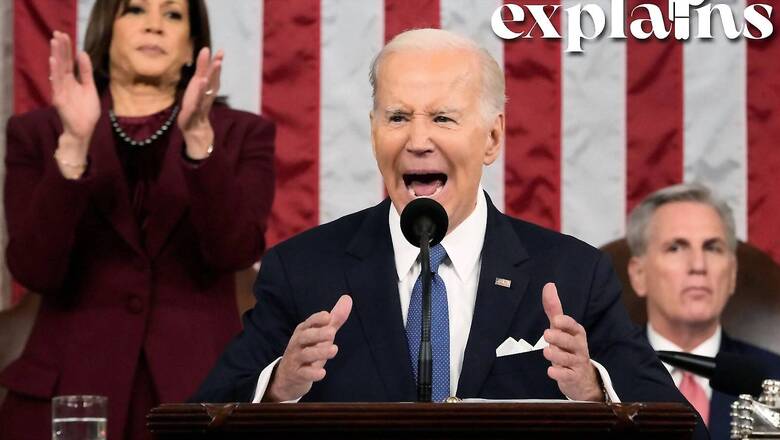
views
President Joe Biden urged unity and touted a blue-collar economic resurgence Tuesday in a rousing State of the Union speech before a raucous Congress that doubled as a bid to persuade voters he still has what it takes to seek reelection at age 80, reports said.
The Democrat, who has been written off even by some supporters as too old, gave as good as he got in an unusually boisterous event, with far-right Republicans heckling and mocking throughout, an AFP report analysed. At times smiling and joking, at times showing anger, Biden concluded his address, viewed on television by tens of millions of Americans, that “because the soul of this nation is strong… the state of the union is strong.”
We are writing the next chapter in the great American story – a story of progress and resilience. pic.twitter.com/jyvEWG5tAL— President Biden (@POTUS) February 8, 2023
And without mentioning the 2024 election, he said: “Let’s finish the job.” The speech, clocking in at 72 minutes, was remarkable for the granular focus on kitchen table issues, rather than soaring rhetoric or foreign affairs.
But what is the state of the union address and what is it’s relevance?
News18 Explains:
Simply put, the State of the Union is the yearly address of the president of the United States to Congress in the US.
Article II, Section 3 of the US Constitution stipulates that the president must periodically report to Congress on the ‘state of the union.’ Although the president typically addresses a joint session of Congress in person, this is not required by the Constitution, Britannica says.
The first two presidents of the United States, George Washington and John Adams, delivered annual addresses to Congress in person, but Adams’ successor, Thomas Jefferson, sent a written report.
Jefferson believed that the personal address was too close to the Speech from the Throne, which is traditionally delivered by the British monarch at the opening of Parliament.
Not until the 20th century did the custom of giving a speech in person become firmly established. In 1913, Woodrow Wilson revitalised and refocused the personal address.
But Jefferson’s Snub May Have Been Out of Fear, Though
As per a Vox report on the history of the address, a 1995 article by Gerry Casper, who was then the president of Stanford University, suggests that Jefferson may have had a more personal motivation for the change; his shyness.
“By omitting the dramatic elements of the presidential address, Jefferson avoided the personal discomfort of his infamous stage fright. Jefferson was a “nervous orator” whose first inaugural address was given “in such a whisper that the majority of the audience could not hear a word he uttered,” he is quoted in the report as saying.
When Did State of the Union Become a Catchy Phrase?
Article II, Section 3 of the Constitution states that the president shall “from time to time report to Congress on the state of the union and recommend for their consideration such measures as he deems necessary and expedient.” However, for over a century and a half, the word “State of the Union” was not used as the title, with “annual message” being the favoured name, the report by Vox explains.
Franklin D. Roosevelt gave the phrase “state of the union” greater importance, particularly beginning in January 1942, just after the United States’ entry into World War II. According to the clerk’s office of the House of Representatives, FDR’s speech “began to be known informally as the’state of the union’ message/address.” A few years later, President Truman formally dubbed it the “State of the Union Address,” and the moniker has since stayed.
We must be the nation we’ve always been at our best.Optimistic. Hopeful. Forward-looking.
It’s time to finish the job. pic.twitter.com/dyHp49G2cd
— President Biden (@POTUS) February 8, 2023
What Does the address Comprise
Earlier Presidents’ Annual Messages featured agency budget requests and overall economic health reports, a report by Indian Express says. Subsequently, as Congress demanded more in-depth reporting on these areas apart from the Annual Message, the Budget Message and the Economic Report were enacted by distinct laws in 1921 and 1946, respectively.
And it’s Political Significance?
As per a report by CNBC-TV18, in current times, the president uses the message to establish the tone for his political objectives for the upcoming year. As is typical for political speeches of this nature, the address also provides insight into the political situation at the highest level. The occasion is also the period when the president receives the greatest attention, making it an ideal opportunity for presidents to highlight their accomplishments and progress.
So What Was Biden’s Message This Time?
As analysed by an AFP report, at the speech’s core was Biden’s boisterous call for Made-in-America nationalism and populist policies to rebuild the industrial heartland — the kind of rhetoric that once helped Trump lead Republican gains in previously Democratic working-class strongholds.
Biden touted unemployment figures, now at a half-century low, and the stabilizing of inflation, as he promised to fight for the “forgotten” people of the economy.
He pitched a centrist, populist vision of a country healing after Covid and the turmoil of Donald Trump’s one-term presidency. And Biden’s patient, even humorous ripostes to Republican jeering backed up his claim to represent a calmer alternative to the still-powerful Trump wing.
With the event sounding more like the British parliament’s Question Time than the staid annual US tradition, Biden declared that American democracy was “bruised” but “unbowed and unbroken.”
On multiple occasions, Speaker Kevin McCarthy, the Republican heading the party’s narrow new majority in the House of Representatives, stood to applaud Biden — and appeared to try to quiet his more radical party members.
Junk fees may not matter to the very wealthy. But they matter to folks in homes like the ones I grew up.It’s time to pass the Junk Fee Prevention Act. pic.twitter.com/6TPEOHK9ow
— President Biden (@POTUS) February 8, 2023
Meanwhile Trump himself, a fierce Biden critic, offered a rare compliment.
“I disagree with him on most of his policies, but he put into words what he felt, and ended up the evening far stronger than he began. Give him credit for that,” Trump wrote on his Truth Social platform.
With inputs from AFP
Read all the Latest Explainers here













Comments
0 comment